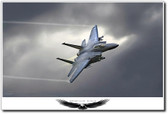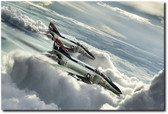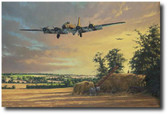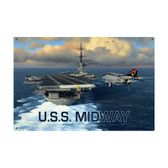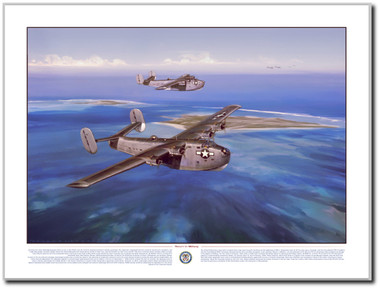 Loading... Please wait...
Loading... Please wait...- Home
- Aviation Art - By Artist
- Jack Fellows
- Return to Midway
Categories
Return to Midway
Product Description
Limited Edition of 199...$200.00
Edition: 199 & 10AP/10 canvas...$285.00
Signed and Numbered by the Artist
Overall Size: 24” x 32”
Image Size: 19” x 28”
Support: Epson archival media/Epson K3 pigment-based ink
Plane Type: PBY-5 Catalina & PB2Y Coronado
Certainly the most challenging aspect of the air war in the Pacific was the extreme distances between airbase and target. The Japanese recognized that they would be facing such a problem, and made long-range a primary design feature for both land-based and carrier-borne aircraft of their navy, and did likewise for their army aircraft. This was a common-sense measure taken by Japanese military planners who had anticipated that a full-scale ocean-wide conflict likely would result from their conquest and occupation of lands colonized by the British, French, and Dutch in Southeast Asia, New Guinea, Borneo, Netherlands East Indies, as well as the American territories of Guam, Philippines, and perhaps, Hawaii.
In spite of the fact that the strategic long-range bomber was a prominent player in the planning of isolationist America’s Army Air Corps decision-makers during this same period (1935-1940), the same level of pragmatism the Japanese applied to aircraft range requirements was not so evident in the U.S. On December 7, 1941 and for at least the next six months, the Japanese were to enjoy a distinct advantage over Allied aircraft in the Pacific theatres as a result of their being able to generally reach further. However, by 1943, long-range raids by Allied land-based aircraft against Japanese-held targets were becoming more commonplace and presaged the extreme long-range B-24 and B-29 missions USAAF groups would be subjecting the Japanese to in the home islands of the Japanese Empire.
The United States Navy was quick to realize that a long reach by patrol bombers (at the beginning of WW II, flying-boats were to fill this role) was a necessity, and the Consolidated PBY-5 Catalina and the Consolidated PB2Y Coronado (pictured above) were excellent examples. In the painting “Return to Midway”, we see elements of VP-102 and VP-13 returning to their seaplane anchorage in the lagoon at Midway, the first week in February, 1944, after a 2100 mile (roundtrip) bombing mission to Japanese-held Wake Island. 18 PB2Y-3s, 12 from VP-13 and 6 from VP-102 participated in 4 night-bombing missions to Wake, 30 January and 4, 8, and 9 February, 1944. These missions, which were flown in support of the invasion of the Marshall Islands, were the first time that USN heavy seaplanes were used in concentrated bombing attacks against the enemy at extreme long-range. Sixty tons of bombs were dumped on Wake in 50 sorties, incurring no losses, whatsoever. Since the Coronado cruised at 110 kts./hour, these missions amounted to at least 19 hours in the air! Capt. Frank De Lorenzo, USN, Plane commander of one of the VP-102 Coronados was the generous contributor of the information used in the execution of this painting.
PLANEJUNKIE - Return to Midway by Jack Fellows - PBY-5 Catalina & PB2Y Coronado



